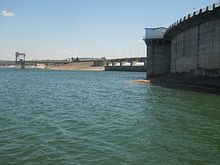| This article needs additional citations for verification. Please help improve this article by adding citations to reliable sources. Unsourced material may be challenged and removed. Find sources: "Stânca-Costești Dam" – news · newspapers · books · scholar · JSTOR (June 2010) (Learn how and when to remove this message) |
| Stânca-Costeşti Dam | |
|---|---|
 | |
 | |
| Official name | Barajul Stânca-Costești |
| Location | Costești (Moldova) / Stânca (Romania) |
| Coordinates | 47°51′30″N 27°15′31″E / 47.85833°N 27.25861°E / 47.85833; 27.25861 |
| Construction began | 1974 |
| Opening date | 5 November 1978 |
| Owner(s) | C.N. Apele Române S.A. |
| Dam and spillways | |
| Impounds | Prut |
| Height | 43 m (141 ft) |
| Length | 300 m (980 ft) |
| Reservoir | |
| Creates | Stânca-Costești Lake |
| Total capacity | 1.29 km (1,050,000 acre⋅ft) |
| Catchment area | 12,000 km (4,600 sq mi) |
| Surface area | 77 km (30 sq mi) |
| Power Station | |
| Turbines | 2 × 16 MW |
| Installed capacity | Moldova: 16 MW Romania: 16 MW |
The Stânca–Costești Dam (Romanian: Barajul Stânca–Costești) is a dam on the Prut River and a checkpoint between Moldova and Romania. The dam is located between Costești (Moldova) and Stânca (Romania).
History

The basic Romanian-Soviet agreement on its construction was ratified in 1972. Built between 1974 and 1978, the Stânca Costești Lake was a USSR-Romanian project. The lake is the reservoir for a hydro power station. The main goal of building this power station was to protect villages down the Prut river from annual floods. The 1970 floods in Romania were the worst in modern Romanian history in loss of life.
On 5 November 1978 the Stânca-Costești Hydroelectrical Plant on the Prut was inaugurated. Romania was represented by Ion Iliescu, the then-Minister of Electric Power Trandafir Cocîrlă, and Chairman Florin Iorgulescu of the Romanian National Council for Water Conservation, while Ivan Bodiul, Minister of Power and Electrification Peter Stepanovich Neporozhny, and Deputy Minister of Land Reclamation and Water Conservation Polat Zade represented the USSR.
References
- Specifications
- Cosmin Pătraşcu Zamfirache (18 July 2015). "Muntele de beton Stânca-Costeşti". adevarul.ro. Adevărul. Retrieved 2 November 2020.
- ROMANIAN-MOLDAVIAN SSR RELATIONS By Patrick Moore and the Romanian Section Archived 2012-02-03 at the Wayback Machine
External links
Categories:- Prut
- Moldova–Romania border crossings
- Dams in Romania
- Dams in Moldova
- Dams completed in 1978
- Hydroelectric power stations in Romania
- Hydroelectric power stations in Moldova
- Hydroelectric power stations built in the Soviet Union
- Bridges in Moldova
- Bridges in Romania
- Bridges completed in 1978
- Bridges over the Prut
- Romania–Soviet Union relations
- Bridges built in the Soviet Union
- Buildings and structures in Botoșani County